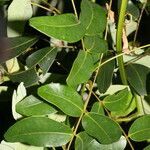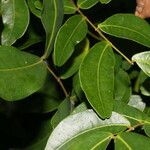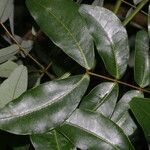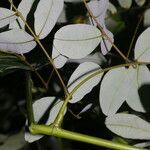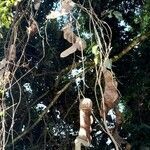Large liane up to 25 m. high, unarmed.. Young branchlets subglabrous to puberulous or perhaps sometimes pubescent.. Rhachis of leaves with (1–)2 pairs of pinnae, and ending in a forked tendril; leaflets (3–)4(–5) pairs, elliptic to obovate-elliptic, often asymmetric, 1.8–8 cm. long, 0.8–4 cm. wide, emarginate at the obtuse or rounded apex, glabrous above except for the puberulous midrib, glabrous also beneath except near base of leaflet and (sometimes) for some pubescence along midrib.. Spike-like racemes arising from stem about 3–5 mm. above leaf-axils, solitary, 8–25 cm. long, ± pubescent, on a peduncle 1.5–6 cm. long; pedicels 1–1.5(–2) mm. long, slender.. Flowers creamy to greenish or yellowish.. Calyx somewhat puberulous or glabrous, 1–1.25 mm. long.. Petals 2.5–3 mm. long.. Stamen-filaments 3.5–6 mm. long.. Pods gigantic, less woody than in E. pursaetha, twisted into a single or double lax spiral, with the sides also often twisted, 0.4–1.2 m. long and 7.5–12 cm. wide; outer layer of pod falling away to expose the thick, chartaceous, somewhat flexible inner layer.. Seeds hard, about 4–5.5 cm. in diameter.
Rhachis of leaves with (1)2 pairs of pinnae, and ending in a forked tendril; leaflets (3)4(5) pairs, 1·8-8 x 0·8-4 cm., elliptic to obovate-elliptic, often asymmetric, emarginate at the obtuse or rounded apex, glabrous above except for the puberulous midrib, glabrous also beneath except near the base of the leaflet and (sometimes) for some pubescence along the midrib.
Pods gigantic, 40-120 cm. x 7·5-12 cm., less woody than in E. pursaetha, twisted into a single or double lax spiral, with the sides also often twisted; outer layer of pod falling away to expose the thick chartaceous somewhat flexible inner layer.
Spike-like racemes arising from the stem c. 3-5 mm. above the leaf-axils, solitary, 8-25 cm. long, ± pubescent, on a peduncle 1·5-6 cm. long; pedicels 1-1·5(2) mm. long, slender.
A woody climber. The fruit is a long woody pod. It can be 1-2 m long. The seeds are heart shaped and can be 6 cm across. They are a shiny deep red to brown.
Large liane up to 25 m. high, unarmed; young branchlets subglabrous to puberulous or sometimes pubescent.
Calyx 1-1·25 mm. long, somewhat puberulous or glabrous, sometimes pubescent.
Coriaceous or subwoody pods curved into a single or double spiral.
A liane, similar to the preceding (Entada pursaetha)
Flowers creamy to greenish or yellowish.
Seeds c. 4-5·5 cm. in diam., hard.
Stamen-filaments 3·5-6 mm. long.
Petals 2·5-3 mm. long.
